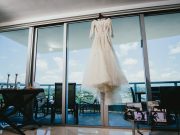
For renowned wedding dresser Caroline Shaw, working with kallot on their wedding day is the culmination of years in the wedding industry. Born in Dublin, Ireland, Shaw, a long-time Chicago resident, has gone from designing dresses to providing a wedding dressing service for brides throughout the city.She began offering dressing as a gift for the brides she outfitted, and it took off from there. “I have experience in dressing people; I have an eye that is fairly refined when it comes to dressing,” explains Shaw, who trained at The Grafton Academy of Dress Design and completed her apprenticeship in a small couture atelier in Dublin.

But not everyone understands what her role is. “People call up and say, ‘Mrs. So-and-So says I must have you, so put me down and call me in about six months because I don’t really know what you do, but I’m told I can’t do without you!’”What she does, is take care of all of the little details in making sure the chatan, kallah, parents, grandparents and bridal party look their absolute best. “I add peace of mind on the day.”Her relationship with a kallah usually begins when she attends a dress fitting, which she uses as an opportunity to meet her clients for the first time. Shaw stresses she is not there to change anything the kallah has chosen – she prides herself on her excellent relationship with the bridal salons with which she works. Rather, she is there to check the fit and detail and to offer her experienced eye.She also learns to button the dress, and how difficult the dress is to get on and, as she says, “to learn the lay of the land,” to discuss expectations and talk about any requests for the wedding day.”
On the wedding day, Shaw typically arrives at the home or hotel about an hour to an hour-and-a-half before the kallah begins to get dressed. She sets up a special area a little bit away from everyone with everything the kallah needs, from her jewelry, shoes and any special things so that nothing is forgotten and the stress levels are kept to a minimum. “Dressing is when the emotions start coming through,” says Shaw.

Once the wedding party is ready, Shaw’s job is to keep everyone looking immaculate. “I like my bride and groom to look as though they just got dressed, which is not easy because you have three or four hours of activity beforehand and often you have ambitious photographers wanting to plonk them in a tree to take fabulous photos.”If she is not with the kallah during the pre-ceremony photoshoot, Shaw says she gives strict instructions – and a warning – to the photographers to keep the dress pristine. “I was hired by the mother and if anything happens to the dress, it’s on me.”Often, however, she is present during the photoshoot and keeps a close eye to make sure everything – and everyone – is looking good. “I look at the wedding party all the time and check what is missing that the photographer might not see. The photographer is looking at space and faces; I am looking just at the clothing. At the end of the day, it makes for better photos.”
She helps the kallah get set up for the bedeken, all the time making sure that everything is in place. Once the bedeken is over, Shaw remains with the bride to make sure the dress still looks perfect. “During a wedding the other day, she says, “the bride was busy praying and I was standing behind her steaming the back of her dress!”

After the ceremony, Shaw will wait outside the yichud room and check the chatan and kallah before they make their entrance into dinner or before they go to take more photos. “I’ll help take the veil off, bring a change of shoes and just bustle the dress.” She’ll also pack away the chatan’s kittel, hand his tallit over to the wedding planner, or put it in a safe place. She’ll also put the kallah’s purse and anything she needs, including more spare shoes, at her seat.
With her years of experience as a dress designer and dresser, Shaw has plenty of advice for kallot choosing their dresses. Before doing anything, she stresses they should not make the mistake of thinking that their wedding day will be a day of rest in a pretty day. “You have to go to work on your wedding day. It’s not the day to be wearing something too tight, too heavy or just too cumbersome. If you are going to hop around and do a lot of dancing, get a dress that will allow you to do that,” she advises.
When it comes to buying a dress, the first thing Shaw recommends doing is setting a minimum and maximum budget and only looking at dresses that fall within those criteria. “Do a little homework on where you are going to shop. Make sure they carry what you like and the designers you like. This is especially important for orthodox brides.”There are a lot of women who have fantasized about their wedding dress for years and are very clear about their style and what they want, but says, Shaw, there are many who do not know what they look good in.
“When you go shopping, tell your consultant what you want and then ask her what she would put you in. They have a good eye for that and they are able to show you what you can do with your figure. That is often where you have the most fun because they are opening up the door to you with dresses you wouldn’t have thought have putting on. You have to be really open to trying on dresses, though. Sometimes dresses have no hanger appeal.”When it comes to finding modest dresses, Shaw recommends being upfront with the consultant from the moment a kallah calls to book a fitting appointment. “You have to be very sure that you are going to right location and the right salon. You need to say, “I am a modest bride, what designers can you recommend who would offer that for me, ask in advance to only look at designers who can do that. If they stock that designer, they’ll have something that has a modest neckline so you can see what it looks like, but you should know some designers won’t do structural alterations because they are pattern changes.”
With changing bridal fashions over the past few years, especially given the “Kate Middleton Effect,” there has been a shift in trends. “There has been a huge uptick in dresses that have sleeves. The strapless look lasted years longer than it should have. We are seeing a big movement towards modesty.”She predicts the change in fashion will be around for a long time. “Now there’s less work in having to choose a dress. You just need the sleeves to be a little longer, or the neck a little higher, but you are now looking at a gown that is closer to [orthodox] criteria.”The increased availability of dresses that can be bought straight from the salon without alternations or that require relatively little alteration also gives kallot options at a better price point.

YOUR OWN WEDDING DRESSER

Don’t forget to break in your shoes before the day of the wedding.You can never have enough shoes! For extra comfort during the photographs, wear a pair you already own that are about the same height as your wedding shoes (but make sure they can’t be seen under the dress).Bring a “first aid kit” of band aids, baby wipes (great for removing deodorant marks) talcum powder (good for underarms, cools the skin, absorbs moisture and won’t stain the dress) moleskin (in case shoes rub) bobby pins, hairspray and a can of static guard.Have a repair kit with a lint roller, needle, thread, a couple of buttons, hooks and eyes and a small pair of scissors close to hand to fix any unexpected emergencies.
Don’t make any changes to your morning routine. The wedding day is not the time to try out new toiletries, products or to do anything that might irritate your skin.If you are fasting, consider what you need to have when the fast ends and how you will feel.
DON’T FORGET THE MEN

While she naturally focuses on the kallah, Shaw, who has a line of custom men’s clothes, is careful not to let the chatan and his entourage be forgotten.“I would like to see my orthodox grooms have more connection with the bride. Often, at these gorgeous, colorful weddings, you could take the men out and put them in anyone else’s wedding. The women talk and they are all in the same color, so why aren’t the men talking and being more coordinated?There’s always a lot of color involved in orthodox weddings. The groom should pick up the color of her dress or the color of the wedding in a tie or bowtie or pocket square rather than just wearing black and white. I’ve seen amazing custom yarmulkes, and that’s certainly one thing they can do.Men in the wedding get a little lost. They tend to go towards rental sooner than they need to. There’s always a need for a great suit and there’s always a need for a tuxedo. Even if he rents a suit or a tuxedo, everything else should be his. He should invest in good shoes, good neck wear and a good shirt.”
BY DANIELLE MAX PHOTOGRAPHY
By CJ Studios Wedding Photography
Danielle Max is a freelance writer and editor. Originally from Liverpool, England, she now lives in Jerusalem with her husband and son. daniellemax@gmail.com












